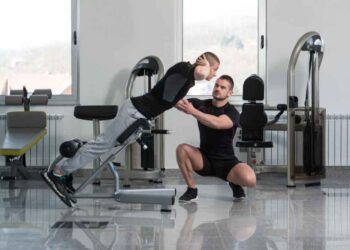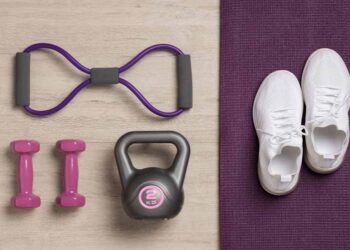Are you looking to take your lower body workout to the next level? Do you want to build strength and sculpt muscle in your legs? Look no further than one of the most iconic exercises in the gym – squats! But what makes squats so special? And why should they be an essential part of your fitness routine? Let’s dive into the benefits of squats and uncover why this classic move is a game-changer for your leg day!
The Power of Squats: A Comprehensive Leg Workout
Squats are a highly effective exercise for targeting the muscles in your lower body. They engage your quadriceps, hamstrings, glutes, and even your core muscles. By performing squats regularly, you can develop strength and muscular endurance in these areas, leading to greater overall athleticism. Whether you choose to do barbell squats, dumbbell squats, or machine squats, incorporating this exercise into your leg day routine will provide a comprehensive workout for your lower body.
Squats are one of the best leg workouts you can do. Not only do they strengthen your muscles, but they also improve your balance and stability. Squats are a compound movement, which means they work multiple muscle groups at once. This makes them highly efficient for building muscle and increasing overall strength.
When performing squats, it’s important to maintain proper form and technique. Start by standing with your feet shoulder-width apart, toes slightly turned out. Lower your body down by bending at the hips and knees, as if sitting back into a chair. Keep your chest up, back straight, and core engaged throughout the movement. Push through your heels to return to the starting position.
Benefits of Squats:
- Builds lower body strength
- Targets multiple muscle groups
- Improves balance and stability
- Increases overall athleticism
- Promotes muscle growth and development
Incorporating squats into your leg day routine can make a significant difference in your fitness journey. Whether you’re looking to build muscle, increase strength, or enhance athletic performance, squats can help you achieve your goals. The versatility of squats allows you to customize your workouts based on your fitness level and equipment availability.
“Squats are the king of all exercises. They engage multiple muscle groups and provide a complete lower body workout.”
– Fitness expert, Jane Smith
Tips for an Effective Squat Workout:
- Start with bodyweight squats to perfect your form before adding weights.
- Gradually increase the weight as you get stronger to continue challenging your muscles.
- Experiment with different squat variations to target specific muscle groups.
- Include squats in your leg day routine at least twice a week for optimal results.
- Listen to your body and rest if you feel any pain or discomfort during the exercise.
Remember, consistency is key when it comes to seeing results from squats. Make them a regular part of your leg day routine and watch as your strength and muscle definition improve over time. Train hard and squat strong!
| Squat Variation | Main Muscles Targeted | Difficulty Level |
|---|---|---|
| Barbell Squats | Quadriceps, Hamstrings, Glutes, Core | Intermediate-Advanced |
| Dumbbell Squats | Quadriceps, Hamstrings, Glutes | Beginner-Intermediate |
| Machine Squats | Quadriceps, Hamstrings, Glutes | Beginner-Friendly |
Barbell Squats vs. Dumbbell Squats vs. Machine Squats: Which Is Right for You?
When it comes to squats, you have several variations to choose from: barbell squats, dumbbell squats, and machine squats. Each variation offers unique advantages and may be more suitable for different individuals based on their goals and fitness level.
Barbell Squats: Barbell squats allow for greater weightlifting potential and target multiple muscles simultaneously. By placing a barbell across your upper back and shoulders, you can challenge your lower body with heavy weights, promoting strength and muscle development. Barbell squats are a staple in many gym exercises and are ideal for individuals who are focused on building strength and increasing overall muscle mass.
Dumbbell Squats: Dumbbell squats provide stability and can be a good option for beginners or those with limited equipment. By holding a dumbbell in each hand, you can perform squats with proper form and control. Dumbbell squats engage your lower body muscles effectively and allow you to adjust the weight based on your fitness level. This variation is beneficial for individuals looking to improve their overall leg strength and stability.
Machine Squats: Machine squats are performed using a squat machine that provides assistance and stability. This can be a suitable choice for individuals with joint issues or mobility restrictions. Machine squats allow you to focus on the movement and target your leg muscles without the added challenge of balancing a weight. This variation is beneficial for individuals who want to perform squats with reduced strain on their joints and can be incorporated as part of a leg day routine.
Ultimately, the choice between barbell squats, dumbbell squats, or machine squats depends on your personal preference, fitness goals, and available equipment. Consider your individual needs and abilities, and choose the variation that aligns with your fitness journey.
Benefits of Barbell Squats:
- Target multiple muscles simultaneously
- Promote strength and muscle development
- Build overall muscle mass
Benefits of Dumbbell Squats:
- Provide stability and control
- Adjustable weights for different fitness levels
- Improve leg strength and stability
Benefits of Machine Squats:
- Assistance and stability
- Reduced strain on joints
- Suitable for individuals with mobility restrictions
The Science Behind Squats: How They Build Strength and Muscle
Squats are an essential exercise for anyone looking to build strength and muscle in their lower body. When you perform squats, you subject your muscles to significant stress, which stimulates muscle growth and enhances strength. This compound movement engages multiple muscle groups simultaneously, resulting in greater overall muscle activation and development. Squats also promote the release of anabolic hormones like testosterone and growth hormone, which further contribute to muscle growth.
By incorporating squats into your strength training routine, you can achieve remarkable results. Not only do squats target the muscles in your legs, such as your quadriceps, hamstrings, and glutes, but they also engage your core muscles for stability. This comprehensive leg workout not only enhances your lower body strength but also improves your overall athleticism.
If you’re looking for a leg exercise that can deliver impressive results, squats are the way to go. Whether you choose to do barbell squats, dumbbell squats, or machine squats, incorporating this exercise into your routine will provide the foundation for building strength and muscle. So, get ready to power through your leg day and unlock your full potential with squats!
| Type of Squat | Main Muscles Targeted | Benefits |
|---|---|---|
| Barbell Squats | Quadriceps, Hamstrings, Glutes, Core | – Allows for heavier weights and increased weightlifting potential – Targets multiple muscle groups at once – Enhances overall leg strength and power |
| Dumbbell Squats | Quadriceps, Hamstrings, Glutes, Core | – Provides stability and balance – Suitable for beginners or those with limited equipment – Helps develop lower body strength and muscle |
| Machine Squats | Quadriceps, Hamstrings, Glutes, Core | – Offers assistance and stability – Suitable for individuals with joint issues or mobility restrictions – Targets lower body muscles effectively |
Conclusion
Squats are an essential exercise for anyone looking to develop their lower body strength and build muscle. Whether you choose to do barbell squats, dumbbell squats, or machine squats, incorporating this movement into your leg workout routine can provide you with numerous benefits. Squats target multiple muscle groups, including the quadriceps, hamstrings, and glutes, making it a comprehensive lower body exercise.
By regularly performing squats, you can improve your overall strength and promote muscle growth in your lower body. This exercise engages a large number of muscle fibers, leading to increased muscular strength and power. Squats also stimulate the release of anabolic hormones, such as testosterone and growth hormone, which further contribute to muscle development.
Understanding the science behind squats and choosing the variation that suits your needs and preferences is crucial in unlocking the full potential of this classic exercise. Incorporate squats into your routine today and experience the transformative power of this game-changing movement. Start with proper form and gradually increase the weight to challenge your muscles and continue progressing on your fitness journey.














